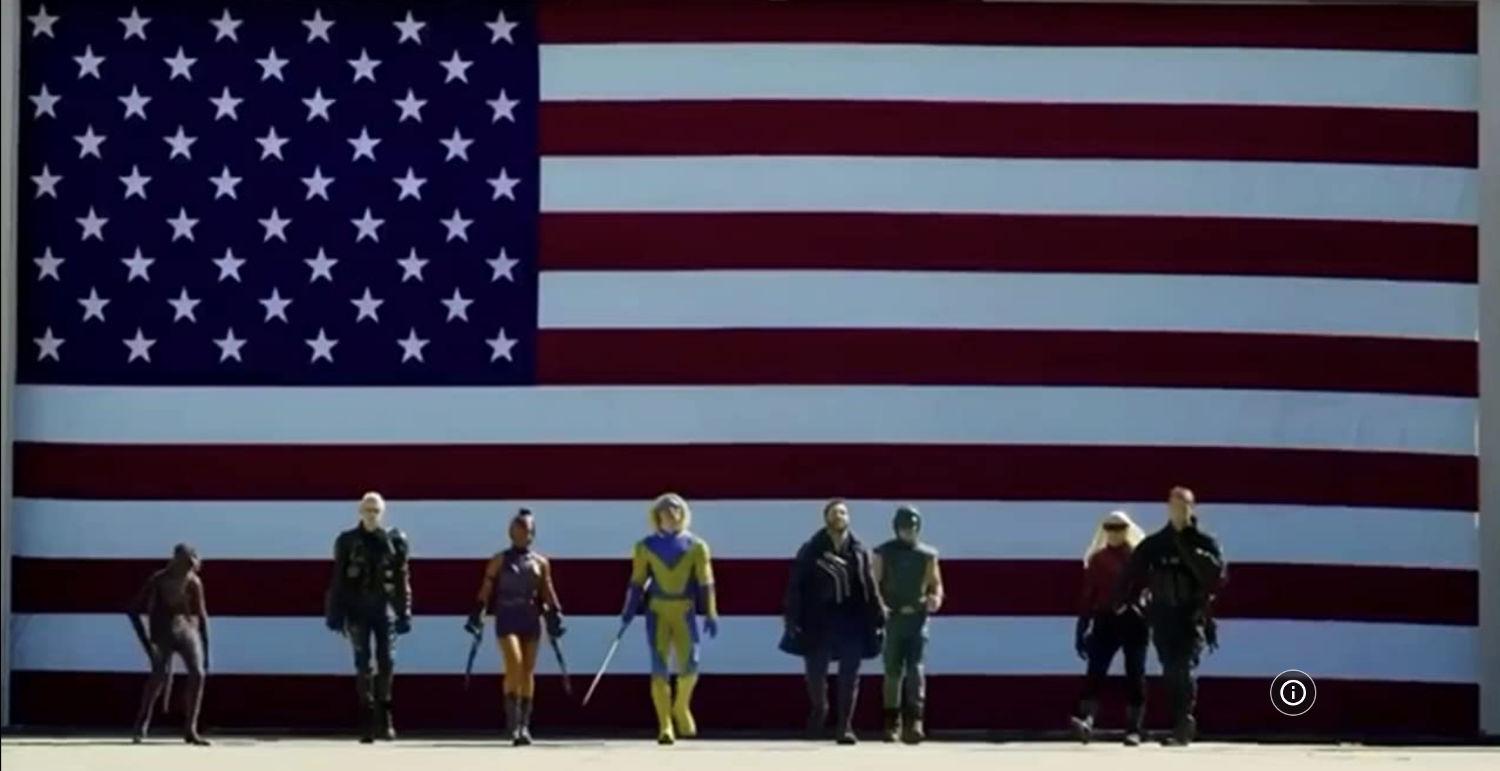
Dark Humour & Insipid Morality
The central conceit of The Suicide Squad (2021) is that an evil government bureaucrat has forced a bunch of villains to work together to save the world. The villains, of course, are reluctant and uncooperative but if they disobey the bureaucrat will press a button, killing the uncooperative villain instantly. The tone, offered by the advertising material, is one of dark comedy. Each character’s poster comes with the text “don’t get too attached,” telling us not only that any character could die at any time, but also that this possibility is part of the movie’s fun. We’re cheering for exploding heads. The trailer promotes the movie as being “from the horribly beautiful mind of James Gunn,” and promotional copy refers to him as “twisted.”

The movie’s pre-credit scene certainly does what it can to live up to its advertisements. We are introduced to Savant, alone with a rubber ball in an open-air jail cell. A bird lands in his cell and, instead of sympathising with it, he instantly kills it with his ball. The camera lingers on the bird’s viscera. We are then introduced to the rest of the initial suicide squad, a bunch of brightly coloured dipshits posing in front of an American flag. They are sent off to invade and overthrow Corto Maltese, a loose analogy of Cuba and Venezuela, as the workers of the government office bet which squad member will die first. Upon arriving, the squad are instantly cornered and killed in increasingly ridiculous ways. Savant, horrified by his team’s collapse, turns and flees which causes the bureaucrat Waller to detonate the bomb inside his head. A bird flies down and picks at the stump where Savant’s head used to be. The blood spells out “Warner Brothers presents.” Dark Humour.
A dark comedy having a moral core is nothing surprising. After all, the audience needs some way to side with the protagonists, and the morally uglier a movie is the more we feel like there has to be some point to it. However, The Suicide Squad goes beyond just having a moral core; it has a moralistic one. And I think this is striking, that a movie that revels in the graphic deaths of its characters could also end up with the tone of Helen Lovejoy’s pleading to “please think of the children”. Now, we could just dismiss this as sloppy writing, as if Gunn went for a simple message and ended up with a simplistic one. But I want to suggest that there’s something interesting going on, and that there’s a deep connection between dark humour and insipid morality.
When I say a movie has “insipid morality,” what I mean is that it presents a moral message that is trite and simplistic; is the sort of thing that would be presented as obvious common sense; and is made stupidly. For The Suicide Squad that insipid morality is an obsession with the purity of children. Much of the core team are understood either as children or in relation to children. Both Polkadot Man and Ratcatcher II are explicitly framed as children whose powers were created by their parents. King Shark, a simple-minded man-eating shark god, is defended by Ratcatcher II for being infantile. Team leader Bloodsport is motivated by the desire to protect his daughter. And Peacemaker… well, John Cena has always had a talent for looking like an overgrown toddler.
The Suicide Squad goes beyond just having a moral core; it has a moralistic one.
Characters often state a motivation to protect children. Harley Quinn kills the president of Corto Maltese after he mentions killing children and she calls that a “red flag” for a toxic relationship. The soldier Rick Flag repeatedly shouts “they experimented on children” in righteous anger. The heroes talk about defending all the innocent children from the mind-slaving starfish. And the office secretary declares “all those people, John. Little kids,” after she incapacitates the evil bureaucrat with a golf club. These declarations of innocence and purity confer a sense of innocence and purity to the protagonists, then, since they were defined as children.
This sort of moral triteness would be a tonal clash with most movies, but it stands out particularly in the context of dark humour. This is because dark humour is interested in transgressing not just moral norms, but all good taste. Take Savant’s brief arc. He kills the bird (moral transgression) and then the camera lingers on the viscera (taste transgression). The movie invites the audience to laugh at him panicking, fleeing, and dying. His arc concludes with his corpse being eaten by a small bird. The humour inheres in the moral and aesthetic ugliness.
There’s a similar dynamic in the characterization of Polka-Dot Man. The original Polka-Dot Man was simply an eccentric who hid devices inside of polka dots on his suit. In The Suicide Squad, the character is infected with an interdimensional cancer virus which manifests in gigantic pulsing multicoloured pustules all over his body. The humour comes both from that being disgusting and the fact that it’s using cancer as the basis of the joke. Often, dark humour targets the very idea of the good, with death itself being the punchline. Polka-Dot Man is killed at his first happy moment, good guy rebels are killed because the protagonists were careless, and there is a repeated joke about Harley Quinn not even knowing who the supporting character Milton was even after he was killed in front of her.

That dark humour is centred not just on the transgression of norms but on the transgression of all norms is, I think, the source of why it can lead to moral insipidity. This is because transgressions create a problem for trustworthiness. What I want to do now is give a brief account of trustworthiness and explain how it gets undermined by dark humour. I’ll then show how insipid morality can be understood as an attempt to restore trustworthiness.
There are two ways to understand someone being trustworthy. The first is just that she is the sort of person who can be trusted.[1] This can mean we trust them in general, but usually trust is particular to certain specific things (“domains” in technical-speak). A stranger may seem trustworthy for me to ask them to keep an eye on my bag while I use the washroom, but I wouldn’t have them take care of my home while I’m away. Another way of understanding trustworthiness is through commitments: a trustworthy person is a person who meets her commitments.[2] These commitments are usually like promises, so if a trustworthy person says she is going to do something, you can count on her doing it.
In each case, trustworthiness seems to fundamentally involve doing what you say you’re going to do. And here is where humour can be a problem, because humour can often involve talking a lot of nonsense. It’s accepted that when you’re joking you don’t mean what you say, thus the phrase “I’m just joking.” The more you don’t mean what you say, the harder it is for me to count on you to do what you say you’re going to do. The more nonsense you talk, the less connection there is between what you say and what you do. The less connection there between what you say and what you do, the less I can take what you say to be an indication of what you’ll do.
Normally we only joke about certain things, and in certain circumstances. I’ll more readily talk about misfortunate befalling me than you, and while I might say anything at the pub I wouldn’t say the same thing in an important meeting. I think trustworthiness makes sense of this: the more likely it is to matter what I say, the less I talk nonsense. The point at which it begins to matter what I say can be understood as (one of the) boundaries of morality and good taste that dark humour transgresses. Remember that dark humour works not only by joking about things beyond morality and good taste, but that crossing those boundaries is central to the jokes themselves. This is to say that when you’re practicing dark humour, you’re talking a lot of nonsense.

This sort of nonsense speak in dark humour poses an additional problem. Normally, if you want to transition from speaking nonsense to speaking seriously, you do something to make clear that you’re now adhering to normal conversational rules. Maybe you change your posture and tone of voice, or maybe you just change topics to something you wouldn’t joke about. But with dark humour, these boundaries themselves are the targets of humour, and so they’re harder to use to make yourself seem serious. Just as turning words to nonsense makes it harder for those words to be taken seriously, turning conventions to nonsense makes it harder for those conventions to be taken seriously. And, as I mentioned earlier, dark humour often targets the very ideas of morality, goodness, and good taste. So not only are words and conventions reduced to nonsense, but so too is the very idea of the good.
If the very idea of morality seems like nonsense coming from you, how do you reestablish that you’re still a good person? Or, at least, not a bad one? If the worry is that the boundaries of good taste have become murky, then the solution can be to redraw them—or at least the ones that matter—as brightly as possible. Here is where moral insipidity starts to come in. Brightly drawn, obvious moral lines to let everyone know that, when it’s important, they can still count on you. But that’s not a full answer. Brightly drawn boundaries can fit with more sophisticated morality too. So why does dark humour lend itself to the insipid? Here are three suggestions.
One possibility I want to reject is that moral insipidity is just a narrative contrivance, to find one final boundary between the heroes and the villains of the story. This may sometimes be the case, but I think there’s also something particular to dark humour. And, also, I think what I’m about to say about moral insipidity goes further than just movies. For one example, I think it helps to explain parts of QAnon, or other forms of conspiracism which are obsessed with the purity and innocence of children.

To start, if the goal is trustworthiness, then that thing re-establishing trustworthiness has to be fundamental. That moral core has to be an absolute moral core, which creates enough moral gravity to ground everything else. This determines insipid morality’s inflexibility. Whenever a character in The Suicide Squad implores us to think of the children, that’s never expanded upon. The only children ever seen, in fact, are Bloodsport’s teenaged daughter and the metaphorical children of the squad. The children we’re being told to think of remain entirely abstract. They’re simply “the children”: some kind of universal absolute. This absoluteness confers reliability, meaning that when it comes to thinking of the children, you can count on the dark humourist.
This absoluteness relates to a second, closely related feature of insipid morality, which is that it has to establish the priority of the moral boundaries in question. Dark humour indulges in transgressing moral boundaries, so any boundary that has to be observed has to be more important than the others. It has to be okay to violate those other boundaries but not this one. If The Suicide Squad invites us to laugh at death, failed attempts at meaning, and the emptiness of the good, then that last inviolable moral boundary has to be placed above life, meaning, and the good.
Insipid morality… is not so much a result of undermining morality as it is a result of trying to reconstruct it.
Lastly, something has to ground that priority and that is a sense of purity. In the genre of dark humour, nearly every boundary is transgressed in the name of humour and nonsense. If the insipid morality is to work to establish trustworthiness, then it has to be free of that meaning- and morality-undermining nonsense. This means it has to stay pure. The priority of thinking of the children, then, finds itself not in that children have potential, or that they are part of a society, or even that they are human, for these boundaries have been transgressed. Rather, The Suicide Squad thinks of the children because the children have been untouched by the darkness of the rest of the movie. The purity of children, then, is free of trustworthiness-undermining nonsense.
These three factors together don’t strictly determine insipid morality. I think it is possible to have moral principles centred on absoluteness, priority, and purity that aren’t necessarily stupid. (Well, I might be a bit surprised if there was a non-stupid morality based on purity.) But, when dark humour does lead to insipid morality, I think this is the path that it travels. And, since the problem of trustworthiness is one that dark humour faces, we should expect dark humour to lead to insipidity fairly often. It’s an ironic conclusion—that transgressive humour should lead to trite, simplistic morality—but I think it’s easy enough to embrace. Insipid morality, if I’m right, is not so much a result of undermining morality as it is a result of trying to reconstruct it. And that’s maybe not the sort of task our darkest, most twisted minds are suited for.
"Footnotes"
[1] For more on this reciprocal approach to trustworthiness see Karen Jones, Trustworthiness, Ethics (2012).
[2] This approach to trustworthiness belongs to Katherine Hawley. You can read more in How to Be Trustworthy (2020).
References
- Hawley, Katherine. How to Be Trustworthy, (Oxford: OUP, 2020).
- Jones, Karen. Trustworthiness, Ethics, (2012).
Further Reading
A short overview of trust and trustworthiness can be found in the Stanford Encyclopedia of Philosophy page on trust.
An introduction to humour, including a discussion of dark humour, can be found in Noel Carroll’s Humour: A Very Short Introduction.
And since I disagree deeply with Carroll, I will selfishly recommend the section on why we value humour from my own piece, The Social Account of Humour.
No comments
Start the conversation…